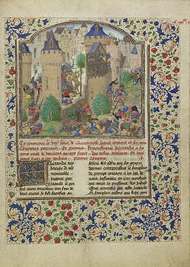 |
 |
 |
 |
Grades/Level: High School (9–12)
Subjects: Visual Arts, English–Language Arts, History–Social Science
Time Required: 3–5–Part Lesson
3-4 class periods
Author: J. Paul Getty Museum Education Staff
Permissions: 
The lesson plan and downloadable materials on this page are licensed under a Creative Commons Attribution 4.0 International License. |
 |
|
 |
 |
 |
 |
 |
 |
 |
Lesson Overview |
 |
Students will compare portrayals of individual soldiers to depictions of battle scenes, write two articles representing two different perspectives about a current war, and manipulate a photograph to alter its mood. |
 |
 |
 |
 |
 |
Learning Objectives |
 |
Students will be able to:
• compare portrayals of individual soldiers to depictions of battle scenes and discuss the impact of each on viewers;
• analyze rhetorical strategies in two newspaper articles about a current war;
• write two different newspaper articles about a current war from different viewpoints;
• create digitally or manually manipulated photographs. |
 |
 |
 |
 |
 |
 |
 |
 |
 |
Materials |
 |
• Reproduction of Alexander Fights in the Town of the Sudracae, attributed to the Master
of the Jardin de vertueuse consolation
• Background Information and Questions for Teaching about the illumination (click on the thumbnail of the illumination below)
• VHS or DVD player and VHS or DVD of a war movie such as Saving Private Ryan (rated R), Apocalypse Now (rated R), All Quiet on the Western Front (not rated), Platoon (rated R), Three Kings (rated R), Letters from Iwo Jima (rated R), Glory (rated R), Stop-Loss (rated R), or In the Valley of Elah (rated R) (optional) (Note: Screen all movies before viewing them with students.)
• Photocopies of a reproduction of Alexander Fights in the Town of the Sudracae
• 3 x 5 inch index cards (one per student)
• Magnifying glasses (one per student)
• Student Handout: Background about "Book of the Deeds of Alexander the Great"
• Photocopies of two different articles about a war representing two different perspectives
• Student Handout: Two Articles, Two Perspectives
• Microsoft® Word software |
 |
 |
 |
 |
 |
|
|
 |
 |
 |
 |
 |
Lesson Steps |
 |
Download the complete lesson by clicking on the "download this lesson" icon above.
Additional Resource:
Zoom in and explore Alexander Fights in the Town of the Sudracae, attributed to the Master of the Jardin de verteuse consolation.
Glossary Terms:
Words in bold on these pages and in the lesson are defined in the glossary for this curriculum (see "For the Classroom" links above).
|
 |
 |
 |
| Alexander Fights in the Town of the Sudracae, Attributed to the Master of the Jardin de vertueuse consolation, about 1470–1475 |
 |
|
 |
 |
 |
 |
 |
 |
 |
Standards Addressed |
 |
Common Core Standards for English Language Arts
Grades 9–12
READING
Key Ideas and Details
1. Read closely to determine what the text says explicitly and to make logical inferences from it; cite specific textual evidence when writing or speaking to support conclusions drawn from the text.
2. Determine central ideas or themes of a text and analyze their development; summarize the key supporting details and ideas.
Craft and Structure
6. Assess how point of view or purpose shapes the content and style of a text.
SPEAKING AND LISTENING
Comprehension and Collaboration
1. Prepare for and participate effectively in a range of conversations and collaborations with diverse partners, building on others' ideas and expressing their own clearly and persuasively.
2. Integrate and evaluate information presented in diverse media and formats, including visually, quantitatively, and orally.
WRITING
Text Types and Purposes
3. Write narratives to develop real or imagined experiences or events using effective technique, well-chosen details, and well-structured event sequences.
Production and Distribution of Writing
4. Produce clear and coherent writing in which the development, organization, and style are appropriate to task, purpose, and audience.
6. Use technology, including the Internet, to produce and publish writing and to interact and collaborate with others.
For more national and California state standards for this curriculum, refer to the charts found in the links at the top right of this page.
|
 |

|
 |
 |
 |



